Results are in for the eighth annual Philly Codefest, presented by American Water and Drexel University’s College of Computing & Informatics (CCI). Due to the COVID-19 pandemic, Philly Codefest 2020 was conducted over the course of eight weeks (Sept. 23 to Nov. 22) in an entirely virtual format.
Both students and professionals from all experience levels and backgrounds collaborated around the world to develop novel, creative solutions to support the City of Philadelphia’s sustainability and climate goals and help make our region a safer, healthier place to be for generations to come. Attendees also participated in virtual workshops and panel discussions presented by Codefest 2020 sponsors and CCI Corporate Partners.
Participants were encouraged to design software hacks around environmental sustainability tools in the following key focus areas: water (e.g., clean water access, wastewater management, stormwater/flood management); agriculture & food (e.g., agricultural pollution/runoff management, green farming, food security); transportation (e.g., green transportation technology and incentives, reducing emissions, public transportation infrastructure); waste (e.g., litter, trash and recycling management, composting); and energy (e.g., renewable energy, energy consumption reduction technology, clean air).
In addition to presenting sponsor American Water, Philly Codefest 2020 was made possible by CCI Corporate Partners Linode, Boomi, BrickSimple, Vanguard, as well as the Clinton Foundation, IBM & Call for Code and Clinton Global University.
More than 260 attendees formed teams to work on projects over an eight-week period, finally virtually presenting their final creations to a panel of judges – comprised of Drexel faculty, alumni, CCI Corporate Partners, sponsors and tech community leaders.
The following nine teams and projects were selected by the judges as the top projects of Philly Codefest 2020:
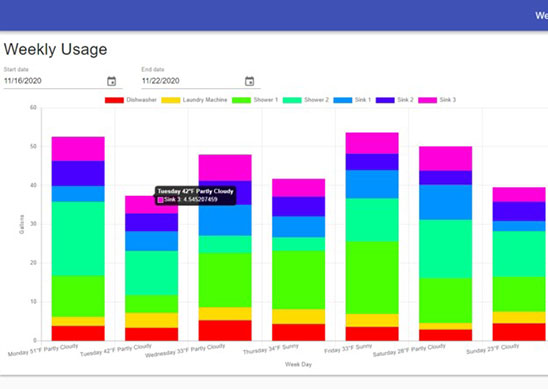 Team Watery doing in Philly (Philly Codefest 2020 Student Team Award; American Water Challenge: Predicting Water Usage Needs based on the Weather)
Team Watery doing in Philly (Philly Codefest 2020 Student Team Award; American Water Challenge: Predicting Water Usage Needs based on the Weather)
Members: Zachary Smith (BS electrical and computer engineering), Stephen Hansen (BS computer science), Daniel Schwartz (PhD computer science), Dennis George (BS computer science), Kristopher Lopez (BS computer science), Damien Prieur (MS robotics and autonomy)
Description: “Our project provides an easy-to-use all-in-one water consumption dashboard. Our contribution provides both an IoT hardware solution to place on water outlets around the house (sink faucets, showers, bathtubs, laundry units, toilets, etc.) as well as a software solution to view water usage and compete with friends. The hardware solution is a small IoT device that attaches easily onto pipes attached to water outlets. These small devices connect to a master hub within the household logging water flow through the pipes and computes how much water is used throughout the day. It can either connect to a water hose (toilets, laundry units), thread in a shower head or can be dropped into the pipe of a sink. When dropped into the pipe of a sink it can help prevent water waste going down the pipes and act as an obstruction. Inside is a mechanical water flow meter using a turbine that rotates with a magnet on it and is monitored by the hall effect and will be logged into the gateway and then sent into the server and logged into the dashboard. The software solution is a dashboard that shows charts of water consumption by device (sink, shower, laundry), which is unique to each household and can be tracked by logging into an account.”
Inspiration: “Water plays a big role in supporting our communities. Without water there would be no local business or industry. Firefighting, municipal parks, and public swimming pools all need lots of water. An array of pipes, canals, and pumping stations managed by our public water systems are needed to bring a reliable supply of water to our taps each day. In the US, we are lucky to have easy access to some of the safest treated water in the world—just by turning on the tap. We wake up in the morning, take a shower, brush our teeth, grab a cup of coffee, and head out for the day. Water is an important part of our daily lives and we use it for a wide variety of purposes, but do we really understand how much we use? The average American family uses more than 300 gallons of water per day at home. Roughly 70 percent of this use occurs indoors. An easy to way to understand individual water use is to look at your water bill—not just the amount due, but how much water you used.”
What’s Next: “We look forward to enhancing the game aspect of our project and introduce leaderboards that compare all users with filters for best in nation, best in state, and best in local area. Additionally, we are excited to see the improvements to our prediction of water usage and weather with our future weather predictions.”
Watch the Watery doing in Philly Demo
 Team LocustTrack (Philly Codefest 2020 Collaborative Award; Philly Codefest 2020 Best Hack for Social Good; Vanguard Challenge - Bring ESG funds to the spotlight)
Team LocustTrack (Philly Codefest 2020 Collaborative Award; Philly Codefest 2020 Best Hack for Social Good; Vanguard Challenge - Bring ESG funds to the spotlight)
Members: Indrashis Mitra, Kartik Agarwal, Nima Pourjafar, Anush Krishna
Description: “Essentially, we track locusts and send warning messages to the registered users. From the satellite data available, we obtain the locusts’ location. We keep a record of the user location and when the locusts enter the vicinity of the user, we warn them via text and WhatsApp.”
Inspiration: “Locust swarms devastate crops and cause major agricultural damage, which can lead to famine and starvation. Locusts occur in many parts of the world, but today locusts are most destructive in subsistence farming regions of Africa. […] The worst locust outbreak in generations has descended upon East Africa and the Horn of Africa. Without immediate action, 4.9 million people could face starvation this summer. This disaster comes at the worst possible time for countries like Somalia already facing the double emergency of food shortage and COVID-19. […] Locust swarm attacks can be prevented with early monitoring of the breeding grounds of the insects. Now, United Nations is already doing this work. Through various ground, air and satellite surveillance techniques, image processing methods, data analysis and a diversified modus operandi, scientists, researchers, biologists are working day in and day out in order to build a model, or a method so that these attacks can be prevented, before they grow to wreck massive destruction and havoc. But the common man cannot comprehend the need or purpose behind all this. So what can we expect from an ordinary let alone an illiterate person to do? Here’s where our application is useful. By making an application in their local language and making it easy to use, we remove any challenges the locals might face while taking advantage of our app.”
What’s Next: “For now we used WhatsApp but if we can implement the project with funding and resources then we plan to use normal text messages. […] As of April 2020, efforts to control the locusts [were] being hampered by ongoing restrictions in travel and shipping due to the COVID-19 pandemic, contributing to the global coronavirus food crisis. Hence, if we can implement Grow N Track, then surely we can put a huge leap in bringing the whole world to normalcy if the nations can slowly go back to their food production levels before the disaster and hence resume trading activities of food and other products.”
Try Out LocustTrack
Watch the LocustTrack Demo
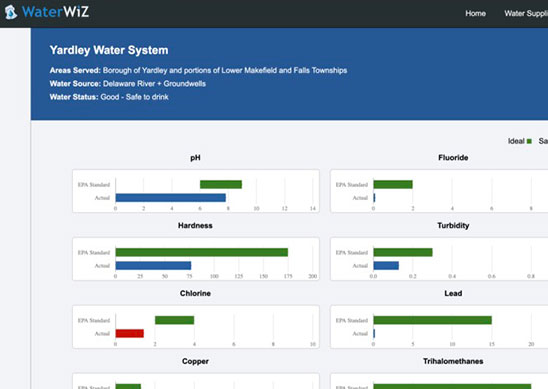 Team WaterWiZ (Philly Codefest Freshmen Challenge)
Team WaterWiZ (Philly Codefest Freshmen Challenge)
Members: Abhishek Jeyapratap (BS computer science), Ryan Magilton (BS computer science), Louis Jorge (BS computer science), Claire Toomey (BS software engineering), Eric Rabil (BS software engineering)
Description: “WaterWiZ gives people easy access to otherwise hard to find water statistics. Our website collects and stores data on 22 water systems and treatment plants, covering 4 water suppliers in the greater Philadelphia region. Using our map page, you can find the closest water system that serves your community. Our water supplier’s webpage has a list of all the suppliers and the areas they serve organized by counties and water systems. At WaterWiZ, we believe everyone has a right to know if their water is safe. Our website has a simple and straightforward organization that makes it easy for anyone to get instant data from their local water system and see if their water is safe to use. Not only do we provide easy access to this data, but the page has ideal values listed alongside the actual reported data. We have also included simple explanations about what the critical parameters and values mean for each of the recorded statistics so that everyone can understand what's in their water.
Inspiration: “As humans, water is essential to everyday life and the environment. Access to safe water has become even more critical especially as we're all stuck at home during this pandemic. Having access to good quality water can also minimize medical expenses for our family and pets and help maintain the efficiency of appliances at home. Unfortunately, access to clean water can be an issue for many. Contaminated water occurs more often than you think. There have been several issues with water quality recently in places like Philadelphia and Montgomery County. Water quality information isn’t easily accessible to the public and can be very hard to find. Even if you do find the local water quality report for your area, it tends to be very long and confusing.”
What’s Next: “Our site allows us to easily plug-in data so we can keep it running with up-to-date water data. We hope to directly work with each water supplier to provide real-time updates about water quality information. We also hope to make this a nation-wide website that can automatically trigger notifications to every household in a certain area when there is an issue with water quality.”
Watch WaterWiz’ Video Demo
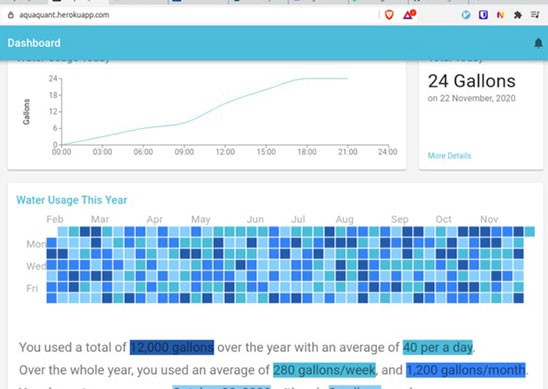 Team AquaQuant (American Water Challenge: Using IoT devices and technologies, identify and suggest ways of reducing water waste within a household or business)
Team AquaQuant (American Water Challenge: Using IoT devices and technologies, identify and suggest ways of reducing water waste within a household or business)
Members: Jacob Shin and Nathan Shin
Description: “AquaQuant is a water utilization quantification/tracking platform that aims to help people conserve more water. Use IoT sensors to automatically track your water usage or use the platform to just manually keep track of your usage.”
Inspiration: “As droughts become more common and fresh water becomes scarcer, it is now more important than ever before to manage our water carefully. Unfortunately, current water monitoring solutions are either too expensive or difficult to setup for the average consumer. Commercial water monitoring products can cost anywhere from \$200 to $700 for a single sensor. Furthermore, currently there is also a lack of water monitoring solutions offered in marketplace for the average consumer. […] This platform hopes to provide a low-cost water monitoring solution for the everyday consumer. Also, by utilizing low cost (Internet of Things) IoT sensors, you can get a detailed breakdown of exactly how much water each faucet, shower, and toilet uses in a given day, week, or month, unlike most commercially available water monitoring products. Note: The IoT sensors are optional. The water usage tracking dashboard also allows users to manually tap on and off whenever they turn the faucet/shower on or off. People track their finances and expenses with a budget or planner; in the same way, we hope people can do the same with water usage by tracking exactly where their water goes.”
See How AquaQuant Works
 Team Aqua-v2.0 (IBM/Clinton Foundation – Climate Change Solution)
Team Aqua-v2.0 (IBM/Clinton Foundation – Climate Change Solution)
Members: Adithya Krishna, Chirag Chandrashekhar, Karthik Ravishankar
Description: “Aqua-v2.0, a smarter and a better way to water is an end to end solution which helps a person to get water from nearby Drinking Water Kiosks through IoT based dispensing and helps a user track the amount of water consumed as well as the Number of Bottles he/she has saved. A user can generate a QR-Code when he/she signs-up and then uses that in his/her water bottle. When scanned using the Aqua app, the response will be sent to a Raspberry-Pi controlled module, which is responsible for dispensing the right amount of water to a bottle. The person can pay towards the water bottle using the in-app payment gateway and 50% of the payment goes towards Charities working towards Saving Water, Reducing Plastic and more.”
Inspiration: “Water, the core element of survival for living beings on the planet and only 2% of the total water available is fit for drinking. Pure drinking water is scarce and expensive in some parts of the world. Plastics, the root cause of Global Warming is the main reason for drastic weather changes across the world ranging from solar flares to untimely sea tides. On an average, 275 million ton of plastics is dumped into seas every year out of which a majority of them are drinking water bottles. In the United States, the Cost for 1L of water is $1.44 which is really high compared to other countries, thus through Aqua-v2.0 we plan to distribute pure drinkable water to the citizens in a new manner while following the contactless way to get it. Many people across the world do not have access to safely managed drinking water and it is mostly due to the lack of resources. Thus, to overcome this, we built Aqua. Also to add to all these, our project is completely dependent on Solar Energy to power the Pump and in the future, we plan to use Solar energy for powering the Raspberry Pi Zero.”
What’s Next: “Make it public, get on-board with the government agencies and add support for larger water kiosks; Power the whole setup using Solar Energy.”
Watch the Aqua v2.0 Demo
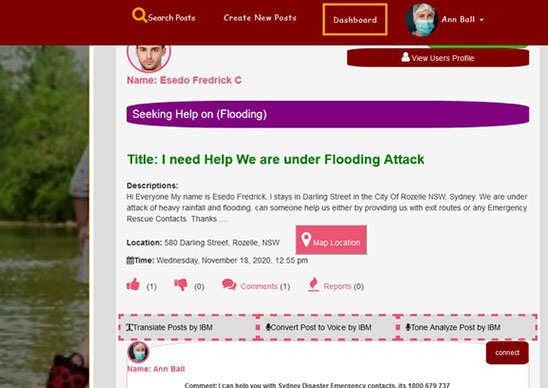 Team Disaster Help – Powered by IBM (IBM/Clinton Foundation – Climate Change Solution)
Team Disaster Help – Powered by IBM (IBM/Clinton Foundation – Climate Change Solution)
Members: Nkemjika Gwacham, Esedo Justina, Fredrick Esedo
Description: “Disaster Help is a platform that brings together those who need help on everyday natural disaster [related] things with those who are willing to help them […] ranging from natural disaster education, environmental advice, disaster exit routes, weather Information, disaster preparedness learning, flooding, earthquakes, wildfires, volcanic eruptions, hurricanes, tornadoes, landslides, etc. [In the application], you can either be a Help Offerer or a Help Seeker. To create a post, one can choose if he/she is offering a Help or Seeking for Help and can pick help [within the] category type.” The team also states that the application leverages IBM Watson Technologies, including the Language Translator, Text to Speech, Tone Analyzer and Weather Company, to perform its various functions.
Inspiration: “According to the Washington Post and Teachers Mutual Bank, something is spreading rapidly around the world in the wake of the COVID-19 pandemic; a new COVID-19 Helpers Connection Movement called ‘caremongering’ is sweeping the globe. According to Teachers Mutual Bank, ‘caremongering’ simply means coming together and supporting one another. In response to the fearmongering/scaremongering that arises following the current coronavirus pandemic, caremongering was created to encourage members of a community to connect with each other in a positive way. The idea behind the movement is to help spread the opposite of panic, driving a real sense of community and helping those among us who are more vulnerable or isolated. People from many different backgrounds are joining these groups to help others within their community, particularly those who are more at risk from coronavirus, in many different ways, including: going to the supermarket to pick up groceries, posting mail, offering professional services remotely, helping in delivering goods, running urgent errands, etc.”
Watch the Disaster Help Demo
Try Out Disaster Help
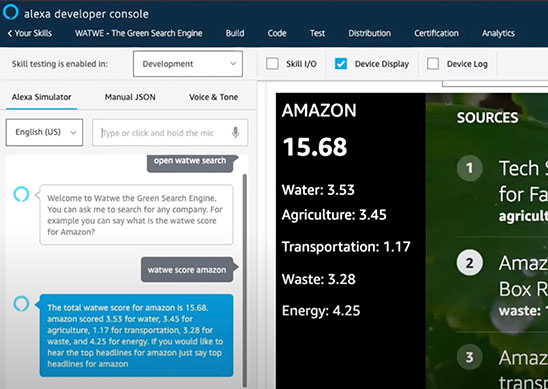 Team WATWE - The Green Search Engine (IBM/Clinton Foundation – Climate Change Solution)
Team WATWE - The Green Search Engine (IBM/Clinton Foundation – Climate Change Solution)
Members: Kevin Carrier, Lenny Ramos, Hai Dang, George Keenan
Description: “WATWE is a search engine that provides a calculated unbiased total WATWE score and environmental headlines for any company the user asks for. The total WATWE score is calculated by doing an internet search for articles about the company using the following five environmental issues as search keywords: water, agriculture, transportation, waste, and energy. WATWE uses the following news sources in its calculation: Google News, Business Insider, Fortune, BBC, CNN, Fox News, ABC News, Tech Crunch, and The Verge. WATWE uses the first 5 articles from each category search and sends the text over to IBM Watson to calculate how positive an article is. The Total WATWE Score is the sum of all of the tone calculations IBM Watson provides.”
Inspiration: “Climate change is a very pressing issue that if not addressed soon could have catastrophic consequences in our future. According to 2019 Porter Novelli/Cone Gen Z Purpose Study, 90 percent of people in the Gen Z Generation believe that companies must drive action on social and environmental issues. Gen Z will make decisions on what brands to buy and use based on how a company is helping tackle the issue of climate change. So, we thought what if there was a measurable way to find out how much a company is investing into combating climate change and know what actions they are taking? Currently there is not a place where you can quickly search for company and find out exactly what actions they are taking to help combat climate change and provide a measurable metric to easily indicate which companies are sustainable.”
Watch the WATWE The Green Search Engine Demo
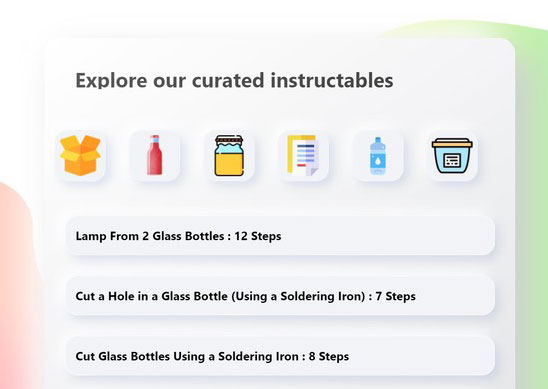 Team Snap N’ Reuse (CCI Most Innovative Award)
Team Snap N’ Reuse (CCI Most Innovative Award)
Members: Shashank Agrawal, Ashish Ohri
Description: “Our app takes images of waste items as input, passes them to an ML model for predictions, and then gives recommendations on how to reuse that item to make something useful. This helps in increasing reusability of waste household items which people normally throw away. The UI of our web app has a simple three-step process:
- application takes an image of a waste item from the user
- our custom ML model runs inference on the image and predicts the waste item.
- based on the type of waste item, curated instructables are fetched for reusing that item.”
Inspiration: “We thought that reusing waste items should be a frictionless experience. Today, there is a need for adapting reusability practices which are simple and easy due to the following reasons: hyper-consumerism in 21st century; lots of waste; oceans polluted with plastics; climate change; reusing is time consuming for people; and recycling not always an option. [Snap N’ Reuse] can be used as an educational tool by teachers to impart practical/real-life environmental education. During the COVID-19 pandemic, co-curricular activities, labs are not being held like before as classes are remote, so teachers can use Snap N' Reuse to encourage kids to make DIY stuff, utilize waste items at home, which will also help in reducing their carbon footprint and they'll be encouraged to lead a greener, more sustainable life from a young age. It also helps in reducing waste on earth, reducing carbon footprint, reduce ocean pollution due to plastic, increasing circular economy. [Snap N’ Reuse can educate] people of all age groups about the importance of reusing, especially youngsters.”
What’s Next: “There are a lot of future prospects and scope for additional features: multi-object detection to make the user experience even better (a user will be able to detect multiple different items in one image and get recommendations to reuse all the items in the image); add a social layer, gamification to increase participation of people; and build an open public database for spreading awareness among the general public against generating a lot of waste.”
Try Out Snap N’ Reuse
Watch the Snap N’ Reuse Demo
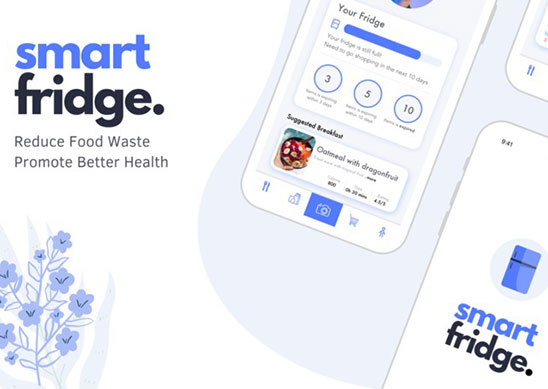 Team SmartFridge (“The Benefits and Costs of Going Digital” Challenge by Boomi, a Dell Technologies business)
Team SmartFridge (“The Benefits and Costs of Going Digital” Challenge by Boomi, a Dell Technologies business)
Members: Nom Phan (BS computer engineering), Quang Luong (BS computer science), Blake Hieu Nguyen (MS software engineering), Ari Nguyen (BS computer science)
Description: “SmartFridge has five main tabs, which are ‘Scan,’ ‘Ingredient,’ ‘Meal Plan,’ ‘Shopping List,’ and ‘Profile’ tabs.
- Scan: Scan images of food ingredients and add to inventory. Integrate image processing functionality through TensorFlow.js to optimize user input step.
- Ingredient: Let user easily monitor available food in their home kitchen.
- Meal Plan: Suggest recipes that match existing ingredients, bookmark favorite recipes, manage weekly meal plan.
- Shopping List: Auto-populated with ingredients user still need for meal plan. Integrate Google Map API to navigate closed-by grocery stores.
- Profile: Summary status of fridge like remaining capacity, prediction of number of days until next shopping trip, number of items expiring very soon, manage ingredients used in the week's meal plan.”
Inspiration: “In the United States, food waste is estimated at between 30 and 40 percent of the food supply (figure from the FDA). Our biggest inspiration stems from our concern about the environment and how we can make simple lifestyle changes be more responsible about our consumption. SmartFridge app is a solution that makes meal-planning convenient, intuitive and sustainable. We create a logistic app that lets users monitor their food resources with ease. By scanning users' food inventory at home via picture input, the app will classify its users' food into categories, come up with suggested cooking recipes depending on the available food, prioritize food that will go bad soon, and send out alerts once the user's fridge is running low or going to expire. With the aforementioned features, SmartFridge app is the all-in-one solution for people to keep track of their fridge, have a more diverse meal plan, and reduce personal food waste.”
Watch the SmartFridge Demo